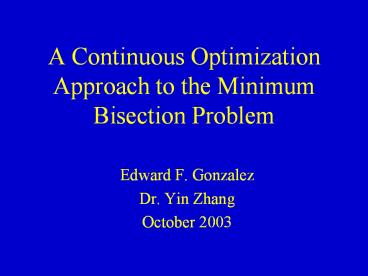A Continuous Optimization Approach to the Minimum Bisection Problem PowerPoint PPT Presentation
1 / 30
Title: A Continuous Optimization Approach to the Minimum Bisection Problem
1
A Continuous Optimization Approach to the Minimum
Bisection Problem
- Edward F. Gonzalez
- Dr. Yin Zhang
- October 2003
2
The Min-Bisection Problem
- G (V,E) is an undirected, simple graph,
where every vertex has at least one neighbor
- V Set of vertices 1,2,...,n
- E Set of edges ? (i,k) 1? i ? k ? n
3
Small Example
1
2
3
- V 1,2,3
- E (1,2), (2,3), (3,1)
4
Larger Example
1024 Vertices 2846 Edges
5
Minimum Bisection Problem
- Objective Divide the vertices of a graph into
two equal groups while minimizing the total
weights of the edges between the groups
V
V/2
V/2
6
Applications of the Min-Bisection Problem
- Parallel Scientific Computing
- Domain Decomposition
- Mesh Partitioning
- Sparse Matrix Ordering
- VLSI Design
- Task Scheduling
7
Many Possible Bisections
- If G has n vertices, there are
- n choose (n/2) possible bisections
8
Easy Problem?
- The Min-Bisection Problem is an NP-hard problem
- Efficient Algorithms for finding exact solutions
unlikely, unless P NP - Heuristics used to solve this problem
- Spectral Bisection
- Multilevel Approach
- Rank-Two Relaxation
9
Spectral Bisection
- Uses the Laplacian Matrix L, where Lij
- deg(vi) if ij
- -1 if (i,j)?E
- 0 otherwise
- L is Symmetric Pos. Semi Definite
- Let x ?? where xi -1,1
- if x 1, x?First Partition
- if x -1, x?Second Partition
10
Spectral Bisection
- xTLx ? (xi- xj)2 4(Cut between Partitions)
- Relax x ? Null(e) ? y ysqrt(n)
- Solved by second smallest eigenvector
- Components of the eigenvector determine Partition
(i,j) ? E
Min xTLx s.t eTx 0 , xi 1
n
11
Rank-2 Relaxation
n
Min (1/2) ? ? wik(1 - xixk) s.t xi 1
? xi 0
- Max ? ? wik xixk
- s.t
- xi 1 ? xi 0
Relaxation Let x ??2
12
vi cos ?i, sin ?iT ? viTvk
cos(?i - ?k)
- Max ? ? wikviTvk
- s.t.
- vi2 1 ? vi 0
vi2 1 automatically satisfied
Max (1/2)W cos(T(?)) ? ??n
Where Tik(?) ?i - ?k
13
- Find a local Minimum of the problem
- Develop a cut (which is also a saddle point)
- Perturb, repeat, and try to improve cut
Rank-2 Feasible Region
Max-Cut Feasible Points
- Notice
- vi 0
- Satisfied
14
- Multilevel Approach
G
G
G1
Coarsen
Gn-2
Un-Coarsen Refine
Gn-1
Cut
Gn-1
Gn
15
Multilevel Techniques
- Coarsen Use a matching criterion
- Initial Cut Various Methods
- Breath First Search
- Refinement Kernighan-Lin type approach
2
1
2
1,2
(2)
1
4
4
3
3,4
3
16
Where we stand
- Currently, the most popular software for graph
partitioning problems is METIS, which uses a
multi-level approach - Rank-2 approach has shown to give either better
or competitive results than spectral or
multilevel algorithms - Rank-2 approach is slow (relative to METIS) and
does not handle large graphs well
17
A Rank-2/Multilevel Idea
- In a multilevel approach graph is coarsened down
to a manageable size and then partitioning takes
placesthis coarse graph may be a good candidate
for the Rank-2 approach - Initial cut will need refinement, use the Rank-2
approach on a small subgraph (Frontier) around
the cut at each level - Proposed solution
- Use multi-level approach in combination with
Rank-2 algorithm (initial cut and refinement)
18
- Multilevel Approach
G
G1
G
Coarsen
Un-Coarsen Refine
Gn-1
Cut
Gn-2
Gn
Gn-1
Area where Rank 2 used
19
Manipulating the Frontier to Produce a Bisection
G
-10
20
Examples and Comparisons
21
Tapir 1024 vertices2846 Edges
Metis
Spectral
58
24
22
Unified
23
- 22(1), 23(2), 24(5), 32, 33
Spectral 58 Metis 24
23
Treexpath
- A graph consisting of two complete binary trees
of k levels, connected by an edge of their
respective root
K2
Depth2
K4
Depth3
24
- Graph Metis Our Approach
- 14-2 276 ? 27 4(14), 8(7)
- 15-2 444 ? 28 4(14), 8(4),
12(6) - 6-79 474 235(16) ?474 (14)
- 6-254 878 352(8) ? 800
(12) - 7-98 292 292(29)
- 7-157 1407 469(7) ?1500
25
Grid3dt
- A 3-D graph in which cells are divided into
tetrahedral
26
- Graph Metis Our Approach
- 20 1239 ? 1239 (28)
-
(Lowest 1183) - 25 2386 ? 1925 (all)
( ? 1900 in 20 runs) - 30 3487 ? 2789
(all) -
2711, 2789 - 35 3649
- 40 5356
27
(No Transcript)
28
Time Comparisons
- Graph Metis Circuit Our
Algorithm - Tapir
- TXP 14-2
- TXP 6-254
- Grid3dt_25
- Grid3dt_30
29
Observations thus far
- Results are promising
- At this point, our algorithm can be used as a
verification tool
30
Future Work
- Improve Run Time
- Get Theoretical Results
- Investigate multilevel coarsening to improve cut
- Run more test on different types of graphs
- Try to be more consistent

